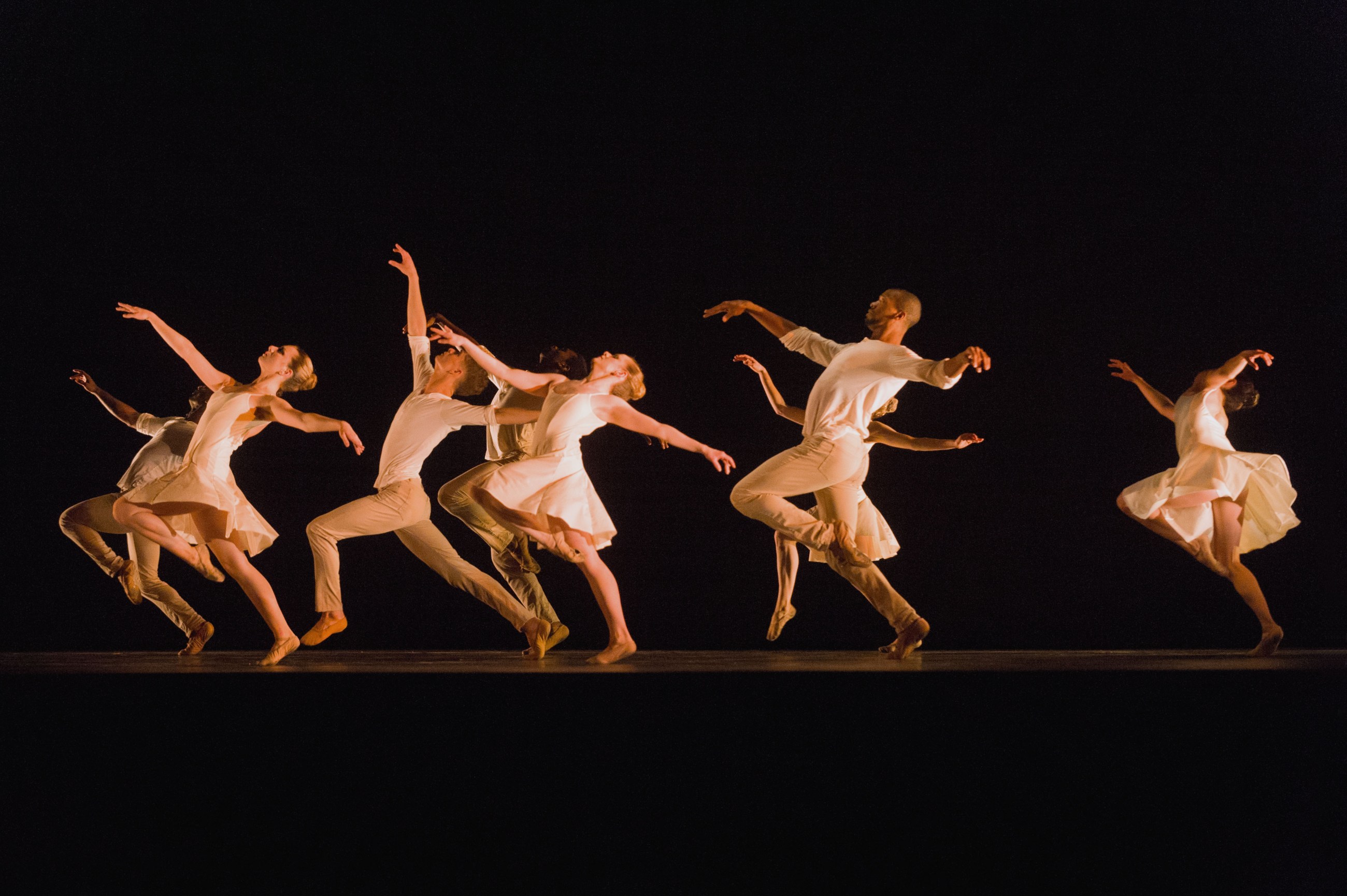
Verb Ballets performed for Heinz Poll Summer Dance Festival in Akron, Ohio
Photo: Verb Ballets performing Royce Zackery’s “Grace” at the Heinz Poll Summer Dance Festival. Photo by Dale Dong.
A summer weekend evening watching a polished professional ballet company perform in a grassy outdoor park. It sounds like a highbrow but comfortable experience, and one exactly like what the Heinz Poll Summer Dance Festival, a Knight Arts grantee, had in mind when it invited Cleveland-based Verb Ballets to perform at Hardesty Park in Akron, Ohio on August 7-8.
It’s been two years since Verb Ballets, which was involved with the festival since its inception, has performed during the annual summer event. On that occasion in 2013, the contemporary dance group kicked off the month-long dance celebration at the very same venue, as reported in an earlier post.
More than one thousand people showed up to see Verb Ballets, settling in on blankets or fold-up seats as the company performed two pieces from its repertoire (“Similar” and “Spring Waters”) and also presented three new works (“Spartacus,” “Ne me quitte pas” and “Grace”). For good measure, the company presented the world premiere of a brand new piece, choreographer Lauren Edson’s “Because This Must Be.”
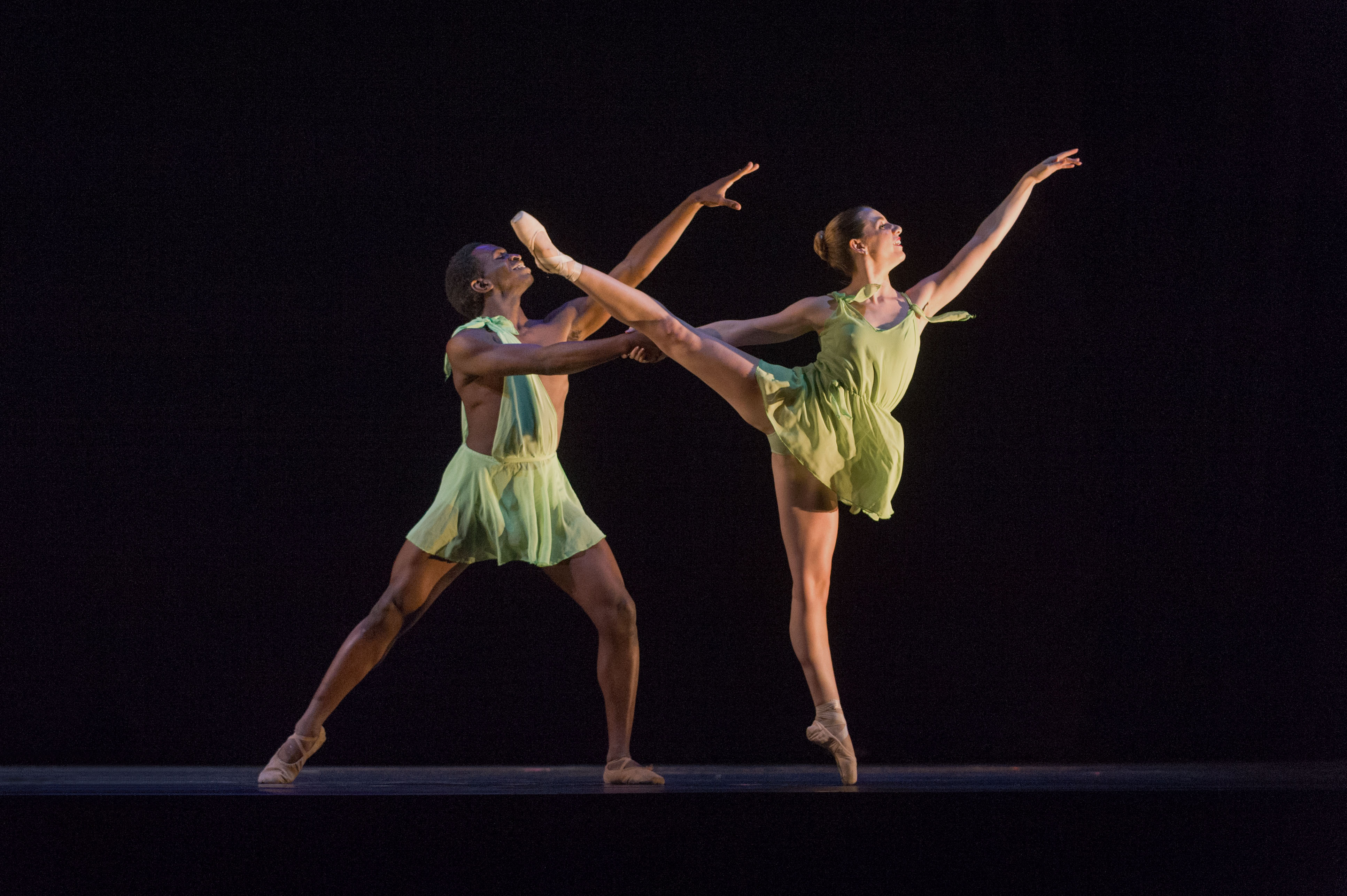
Verb Ballets performing Asaf Messerer’s “Spring Waters” at the Heinz Poll Summer Dance Festival. Photo by Dale Dong.
The program began with “Similar,” a dance that included all eight members of the company. Perhaps to underscore the title, pairs of male/female dancers were dressed in similar costumes, but of different colors–there were shades of yellow, blue, green and brown with cross-matched bottoms and tops.
“Similar” is clearly a modern ballet, but informed by classical ballet technique. Each of the three sections of the work came across as having a very intimate quality, but with a degree of formality that made it seem both delicate and refined. The couples stayed close to one another, with low-to-ground spins and lifts. Female dancers’ arms curved closely to the body, while male dancers remained ever near to catch the women as they dropped trustingly into their partners’ arms.
Couples worked in parallel to one another, with the ensemble following the tenor line of the spare-sounding music (piano paired with harp, or piano and violin). With little layering of the choreography, the musical effect supported the idea of comparableness. Dancers would move closely to the music, even when doing dance phrases in sequence.
“Similar” looked wonderful as performed by Verb Ballets. It clearly is a ballet that should remain in its repertoire. The audience seemed to think so, for many were on their feet at dance end. You do not generally see that response for an opening work in an evening-long performance.
It was before intermission that Verb Ballets premiered “Because This Must Be.” As a figurative exclamation point to the title, the dance ends with a female dancer deliberately putting a male dancer in line with the rest of the eight-person ensemble, which is strung out across the stage. It was as though she were emphasizing (or perhaps hoping) that this is how it should be.
“Because This Must Be” is a complicated, interesting work. The music had an industrial, eerie quality to it and was in dissonance to the fluidity of the movement. Couples danced behind one another, doing separate dance phrases, yet each section was filled with lots of leaps as female dancers jumped into the arms of their partners.
The dance seemed to be structured on the ideas of exploration and discovery of how people either get together or stay together. At one point, for example, seven dancers were crouched and joined together in a pack, hanging on to a single female dancer who stood out in front. It wasn’t clear whether the group was holding her back or she was dragging them behind her.
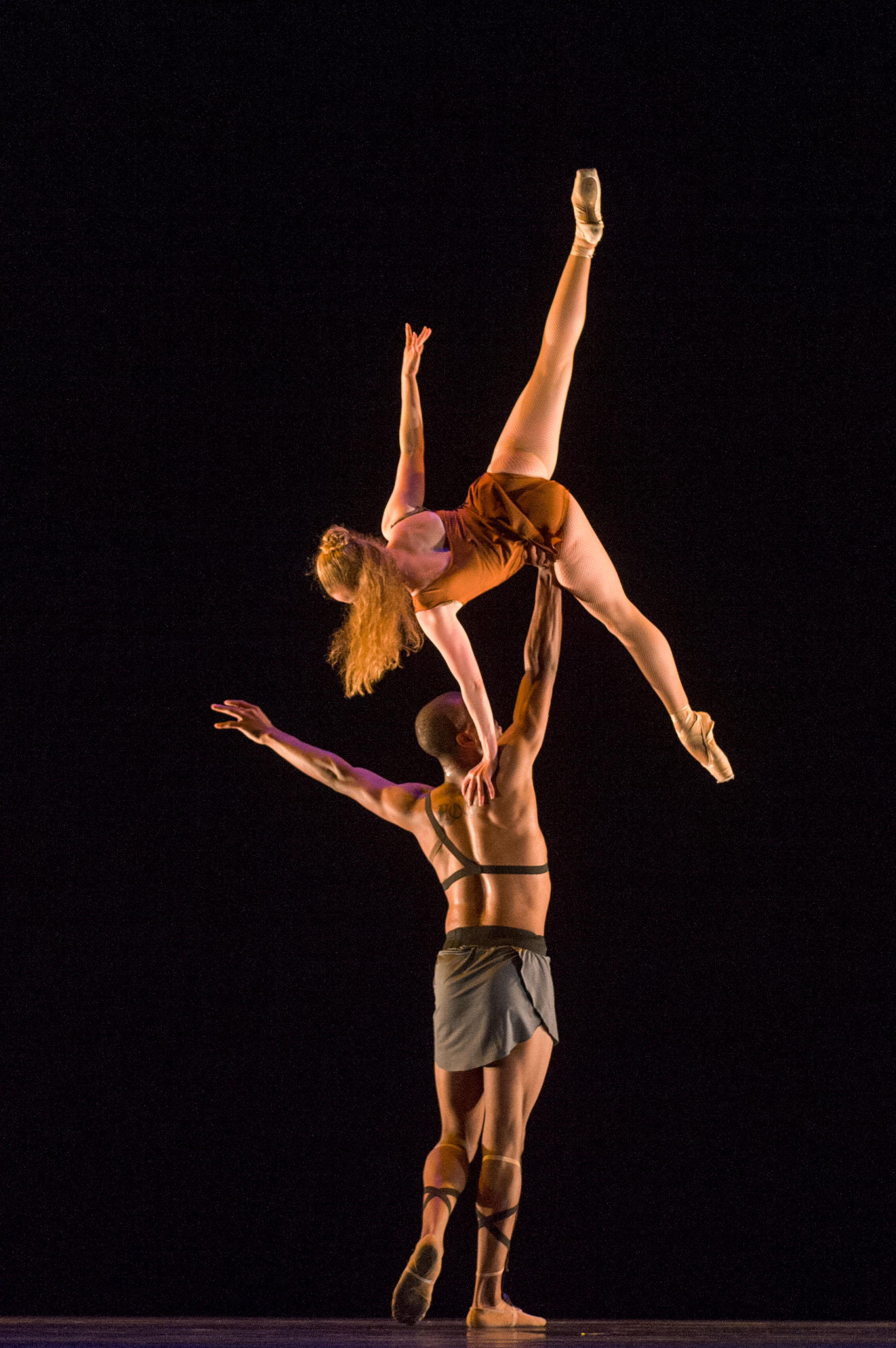
Verb Ballets performing Yuri Grigorovich’s “Spartacus” at the Heinz Poll Summer Dance Festival. Photo by Dale Dong.
After intermission, Verb Ballets performed three short, back-to-back pas de deux works. The three worked off different notions of love relationships. The first, “Spartacus” (1968), a piece by Yuri Grigorovich set to Aram Khachaturian’s music, takes a scene from the story ballet about the leader of a revolt against ancient Rome. The scene reads like an aube (or dawn song) where lovers awaken to face a difficult day. In this case, Spartacus is being torn away from his beloved. He is eventually executed.
The pas de deux is very Russian–that is, it focuses on the long, lean line of the dancers. The impression conveyed is of the dancers needing to remain together, although with the awareness that this will not be possible. The swells in Khachaturian’s music matched, in this performance, the passionate choreography where dancers held and caressed one another and, through the strength of the male dancer, exalted one another through high overhead lifts and frenzied leaps.
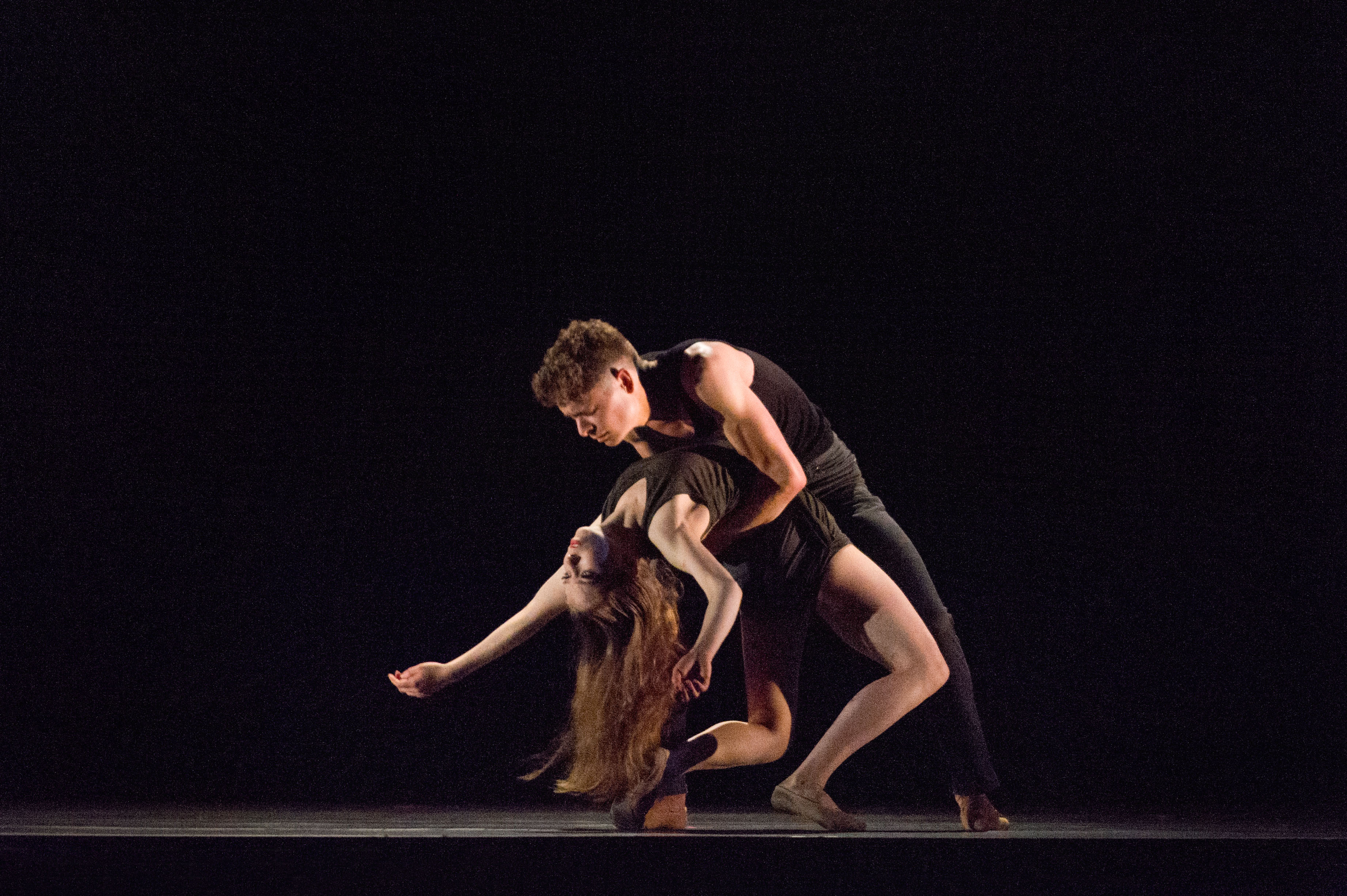
Verb Ballets performing Daniel Precup’s “Ne me quitte pas” at the Heinz Poll Summer Dance Festival. Photo by Dale Dong.
The second pas de deux, Daniel Precup’s “Ne me quitte pas” (or “Don’t Leave Me”) is much darker in tone and execution, as the title would suggest. The music, composed by Jacques Brel, features a singer who keeps chanting out the title phrase over and over as the dancers, dressed in dark brown costumes, created a feeling of dread through languid movements. At one point the dancers seemed to collapse into one another as though exhausted. At the end, the woman character seemed to die in her lover’s arms as the lights faded.
The final pas de deux, Asaf Messerer’s “Spring Waters,” completely changed emotional gears. This work, set to Sergei Rachmaninoff’s music, was as light and frolicsome as “Ne me quitte pas” was dark. In light green, frothy tunic costumes, the couple soared with high energy and even higher lifts through the rousing music. The love dance ended with the male dancer carrying the ballerina off in an emotionally upbeat overhead lift.
The pas de deux pieces worked well together. They are short, and they have clear narrative and emotional patterns that allowed the audience to get what the choreographers were after. Together, they presented a tidy package of studies on the topic of love.
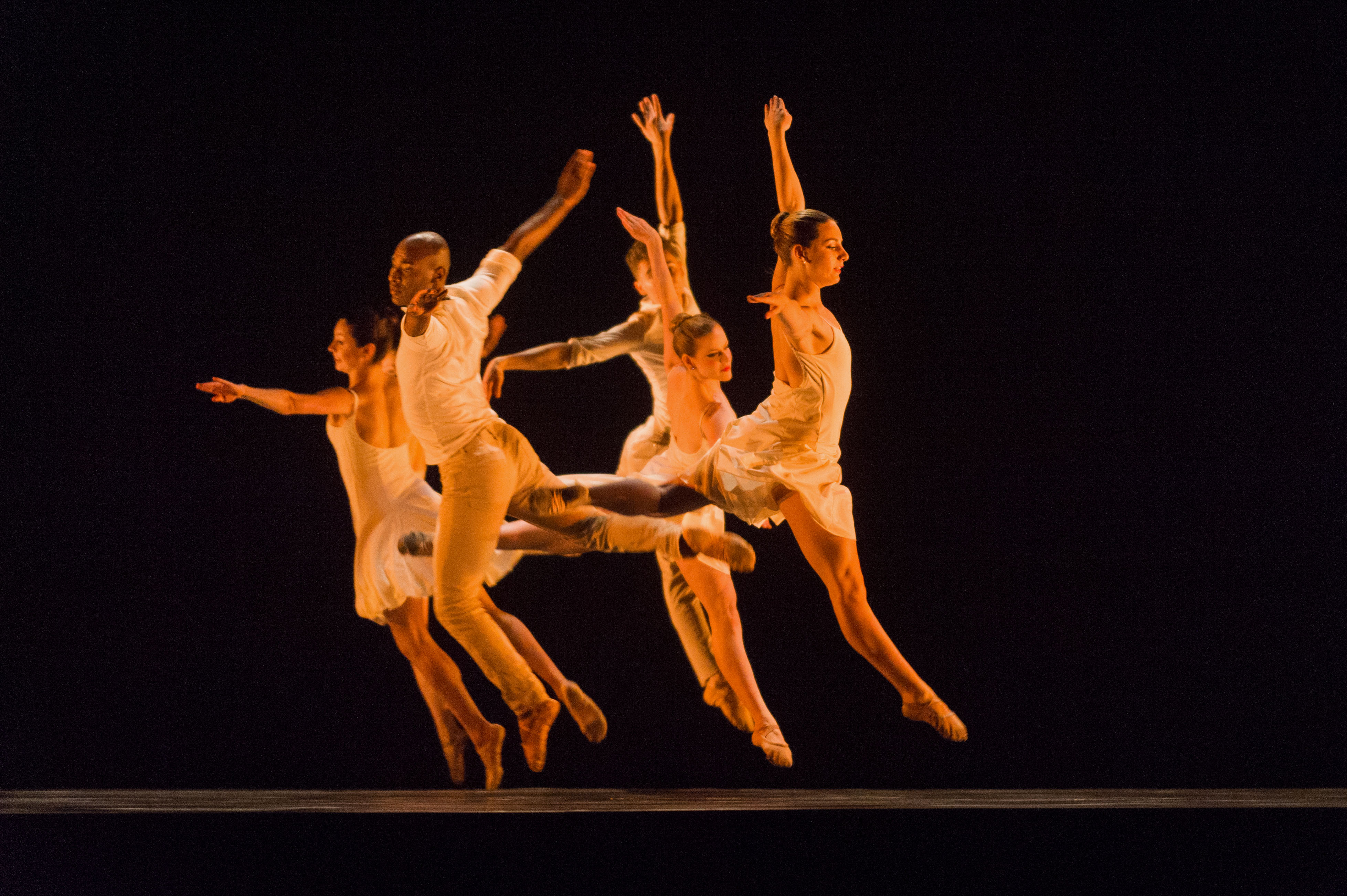
Verb Ballets performing Royce Zackery’s “Grace” at the Heinz Poll Summer Dance Festival. Photo by Dale Dong.
Verb Ballets’ final dance for the evening was Royce Zackery’s “Grace.” Set for all eight dancers in the company, who were dressed in all white (women in dresses and men in white shirt and pants), the multipart work exuded gracefulness. Unlike in earlier pieces, the dancers used frequent wide arm movements to signal the idea of flowing and floating across the stage. The dance vocabulary was more lyrical line than one of athleticism.
The audience seemed to love the work. Many got to their feet for the dancers’ curtain calls. Comments overheard on the way out included gushing about this work in particular and the concert in general. There is clearly an appreciative dance audience in the Akron area.
Verb Ballets is conscious of bringing back classic pieces, like Grigorovich’s “Spartacus” and others. For most audiences, the works are new, just as they are to the dance company. When restaged, as was the case here, the dances seem as fresh as the most recently choreographed pieces on the dance bill. Both the performance and the specific works were a nice addition to the Heinz Poll Summer Dance Festival.
Recent Content
-
Artsarticle ·
-
Artsarticle ·
-
Artsarticle ·

